

The styloid process is a small pointed outgrowth extending from the terminal end of a bone. It is an important site of attachment for different muscles. This Buzzle post tells you about the types of styloid processes and their functions.
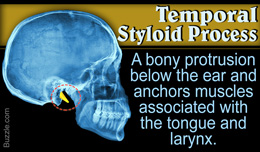 Did You Know?The presence of the styloid process of the third metacarpal bone (located in the hand bone) is a unique anatomical feature of humans, which is absent in apes and nonhuman primates.The styloid process is a small pointed bony prominence extending from a bone that acts as an anchoring site for muscles and ligaments. Though a small projection, it plays an important role as an anchor to several muscles. Depending upon which bone in the body shows this bony projection, it can be classified into the following types.Temporal Styloid ProcessThis is a conical protruding part of the temporal bone located just below the ear. Temporal bone is an irregular-shaped bone that lies exactly on either side of the skull and is an integral part of the base of the skull. It is located in the lower region of the skull, just below the temple area and contains the delicate structures of the ear.
Did You Know?The presence of the styloid process of the third metacarpal bone (located in the hand bone) is a unique anatomical feature of humans, which is absent in apes and nonhuman primates.The styloid process is a small pointed bony prominence extending from a bone that acts as an anchoring site for muscles and ligaments. Though a small projection, it plays an important role as an anchor to several muscles. Depending upon which bone in the body shows this bony projection, it can be classified into the following types.Temporal Styloid ProcessThis is a conical protruding part of the temporal bone located just below the ear. Temporal bone is an irregular-shaped bone that lies exactly on either side of the skull and is an integral part of the base of the skull. It is located in the lower region of the skull, just below the temple area and contains the delicate structures of the ear.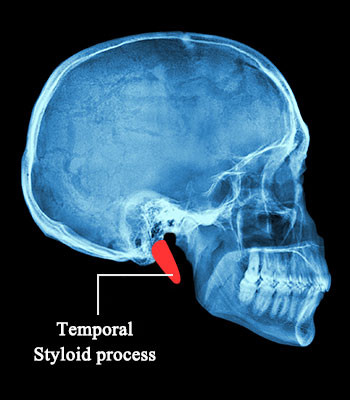 The styloid process of the temporal bone is a small bony growth protruding in the downward direction from the temporal bone. This thorn-shaped bone acts as a point of attachment for the muscles associated with the tongue and the larynx. This anchoring of muscles plays a crucial role in the proper movement of delicate organs such as the tongue. In short, the tongue's mobility is effectively supported by its adhesion to the styloid process.
The styloid process of the temporal bone is a small bony growth protruding in the downward direction from the temporal bone. This thorn-shaped bone acts as a point of attachment for the muscles associated with the tongue and the larynx. This anchoring of muscles plays a crucial role in the proper movement of delicate organs such as the tongue. In short, the tongue's mobility is effectively supported by its adhesion to the styloid process.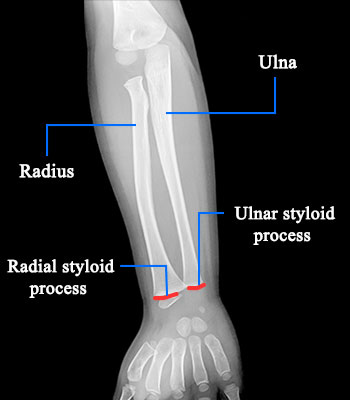 The ulnar styloid process is usually less than 6 mm long but if it elongates beyond its normal length, the condition is referred to as ulnar styloid impaction syndrome that is typically marked by chronic wrist pain. The treatment usually involves surgical removal of the ulnar styloid process to get rid of the wrist pain.Radial Styloid ProcessThe radius or the radial bone is the forearm bone that runs from the elbow to the wrist and lies on the thumb side of the forearm. The styloid process of the radial bone lies on the distal end of the forearm. The radial bone that terminates in the styloid process serves as a point of attachment for the collateral ligament associated with the wrist.Fracture of the radial styloid process is commonly referred to as the chauffeur's fracture and occurs when the scaphoid bone of the hand exerts excessive pressure on the styloid process of the radial bone. This sort of injury often results from falling on an outstretched palm.Third Metacarpal Styloid ProcessThe metacarpal bones lie within the hand and extend from the wrist and connect to the finger bones. They join the knuckles of each finger. Although there are 5 metacarpal bones in the hand, only the third one has the styloid process.
The ulnar styloid process is usually less than 6 mm long but if it elongates beyond its normal length, the condition is referred to as ulnar styloid impaction syndrome that is typically marked by chronic wrist pain. The treatment usually involves surgical removal of the ulnar styloid process to get rid of the wrist pain.Radial Styloid ProcessThe radius or the radial bone is the forearm bone that runs from the elbow to the wrist and lies on the thumb side of the forearm. The styloid process of the radial bone lies on the distal end of the forearm. The radial bone that terminates in the styloid process serves as a point of attachment for the collateral ligament associated with the wrist.Fracture of the radial styloid process is commonly referred to as the chauffeur's fracture and occurs when the scaphoid bone of the hand exerts excessive pressure on the styloid process of the radial bone. This sort of injury often results from falling on an outstretched palm.Third Metacarpal Styloid ProcessThe metacarpal bones lie within the hand and extend from the wrist and connect to the finger bones. They join the knuckles of each finger. Although there are 5 metacarpal bones in the hand, only the third one has the styloid process.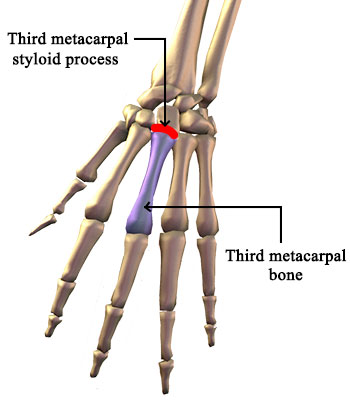 The middle finger is connected to the wrist through the styloid process of the metacarpal bone. This styloid process at the third metacarpal bone acts like a locking mechanism between the hand and the wrist bones. This enables the thumb and fingers to put more pressure on the hand, without which it won't be possible to grasp objects and use complex tools. This styloid process enables us to skillfully use tools with great precision.Fifth Metatarsal Styloid Process (Tuberosity)
The middle finger is connected to the wrist through the styloid process of the metacarpal bone. This styloid process at the third metacarpal bone acts like a locking mechanism between the hand and the wrist bones. This enables the thumb and fingers to put more pressure on the hand, without which it won't be possible to grasp objects and use complex tools. This styloid process enables us to skillfully use tools with great precision.Fifth Metatarsal Styloid Process (Tuberosity)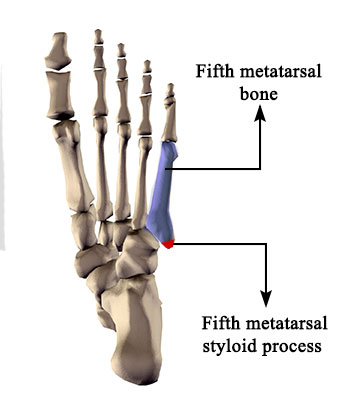 The metatarsal bones are long bones that lie in front of the ankle and terminate at the base of the toes. This styloid process is a small bony projection that extends in the lateral direction from the base of the fifth metatarsal. Fracture to this styloid process leads to pain, redness, and localized swelling at the base of the fifth metatarsal.
The metatarsal bones are long bones that lie in front of the ankle and terminate at the base of the toes. This styloid process is a small bony projection that extends in the lateral direction from the base of the fifth metatarsal. Fracture to this styloid process leads to pain, redness, and localized swelling at the base of the fifth metatarsal.
Copyright © www.orthopaedics.win Bone Health All Rights Reserved